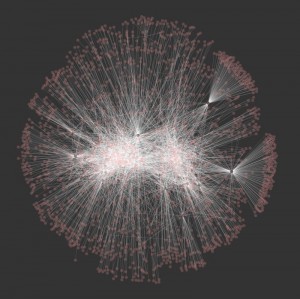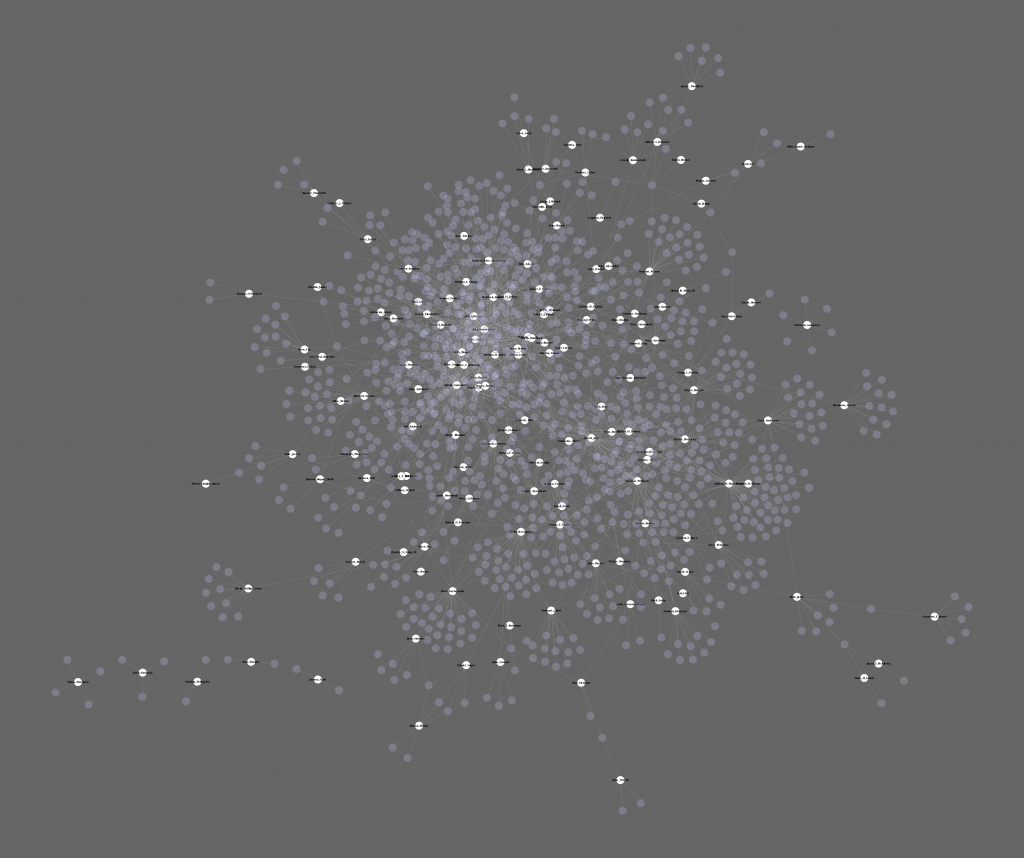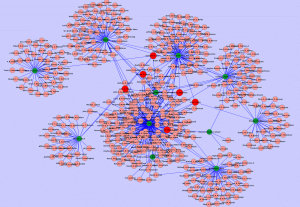The two clusters in the core are roughly split into Democrats (l) and Republicans (r).

Built from data by LittleSis.org. As always, click for larger image.
The two clusters in the core are roughly split into Democrats (l) and Republicans (r).

Built from data by LittleSis.org. As always, click for larger image.
3.6-times as many former congressional staffers turned health care lobbyists and their immediate connections have network ties closer to former President Bush, than to current President Obama.
The connections in the network map shown below, and used for the analysis above, include people and organizations (e.g. corporate, not-for-profit, public, etc.) the people have been identified with.
Other trivia: Continue reading “Health Care Leans Republican”
What it look like if you took all of the Mathematics articles from JSTOR, the digital journal archive, and mapped co-authorship of the papers? It would look something like this. Interesting to note, that while the distribution does hold to the small world network distribution exponent, there’s some “peakiness” about it that may suggest it’s not really one network, but the merging of several. Given the role of mathematics on so many other subjects, that would not be a surprise.

Zoomable image with names, after the jump.
Thanks everyone for showing the strong interest in the Lobbyist map. I got a couple nice mentions at Mother Jones and LittleSis.org, but more importantly, I’ve added in all of the other names in the map.
Circles are people, squares are organizations, and white circles are the lobbyists in question.
If you’d rather the image than the flash bits, here you go, all 2.5MB of it.
A zoomable version of the earlier map is here:
[Thanks to Drew Conway for the Sea Dragon zoomable suggestion]
The Huffington Post, along with public contributors, has been collecting a list of former Congressional staffers turned healthcare lobbyists. LittleSis.org has been keeping track of these former staffers, and thanks to their API, we now have a social graph of their relationships.
Former staffers in white (with names), and the rest of the visual field to show that some are MUCH better networked than others.
If there’s interest, I can add the names of the people they are networked with and start some analysis of the group.

As always, click for a larger image.
Update: network map with all names, and in a zoomable widget here.
Late last month, the NY Times had an article about the debate over healthcare legislation taking place in the Senate Finance Committee. Coincidentally, around that time, the folks over at LittleSis, the “free database detailing the connections between powerful people and organizations,” were kind enough to give me early access to their API (thanks Kevin and Matthew!).
So from NY Times:
To LittleSis:
Of the named members in the photo, neither Tom Barthold nor Phil Ellis existed at the time in the LittleSis database, but it’s still showing a pretty networked bunch.
I’d like to see someone do this one better, and include donors.
Creating a network from a sample of communications from approximately 900,000 people on Twitter, the distribution of distinct communication partners result fits the definition of a scale-free network. The power is a little higher than scale-free networks usually described for social networks (2<k<3), but not much.
I wanted to put out what’s been done so far on making yesterday’s post more interactive. There’s an awful lot that could be better about this map. Particularly legibility of labels in the core (it’s just too dense). If you want to see names, I suggest looking at the edges of the map.
Michael Bommarito is looking into better layouts for legibility. And while you are waiting, I suggest getting your fill of everything he’s ever written.
The data was collected from OpenSecrets.org.
[21-Apr-2009: You should see a flash image above, but am having an awful time getting this to render on a Mac. Works great on Linux (Red Hat Enterprise Linux).]
With a goal of transparency,  LittleSis.Org has started collecting peer-membership information for public figures of many sorts. Just the stuff made for social graphs!
LittleSis.Org has started collecting peer-membership information for public figures of many sorts. Just the stuff made for social graphs!
This is image represents the social networks of the CEOs of the American Wall Street companies, from the info at LittleSis. Red nodes are the CEOs (Thain is included), and green are organizations.
The data is a work in progress, as it only represents a few organizations these folks are involved with; but a work in progress is progress indeed.
P.S. LittleSis: API pretty please!
The real questions are: whom do we trust, why, and under what conditions is trust transferable?
Chris Brogran asks: How does the web define authority?
First is an important matter of language. There is a large difference between authority and an authority. Authority is power formally granted by a position or role. An authority is some who has power or influence; it’s a matter of trust by others for a given context. E.g. I trust my doctor to diagnose an illness, but have no reason to trust him on gardening.
There are many reasons we (dis-) trust others, including: shared opinions; length, frequency, and consistency of interactions; and how our peers feel about the individual the given context. These are all correlated, but frequency and peer opinion have the biggest impact on transferability of trust.
How use doth breed a habit in a man! — William Shakespeare, Two Gentlemen of Verona
Frequency can be no surprise, it’s the underpinning of blanket marketing. Familiarity bred through repetition. Ever wonder why you stop on a TV show you dislike while flipping through the channels? Of course, that could be me making excuses for lousy taste.
Peer consideration is the tricky bit. There is a lot of research going into this, but there are some great seminal works that are written for non-academics covering the spread of innovation and adoption of scientific principles.
When our peers already have some experience or opinion on a topic or an authority, then our own opinions are strongly colored by these existing opinions. In fact, as odd as it may sound, given a pattern of relationships where the opinion of all but one individual is known, we can predictably estimate both what the opinion is, and how strong the opinion is, of the unknown person.
But how about when we something brand new to us and our peers? Frequency plays a big role here too. If lots of people, even people we know nothing about, say XYZ is a good idea, we’re likely to give it the benefit of the doubt, trusting the wisdom of the crowd.
So, strictly speaking, is (dis-) trust transferable? Depends. If trust already exists in our network of peers, yes, and predictably so. If the context is brand new to you and your peers, there is no trust to transfer, but we use frequency as a proxy in our decisions.
So what does this all mean? Let’s look at an example: you’re trying to decide whether you agree (trust) what I have written.
I am new to writing about this, and I’m not particularly active in social media, so chances are we don’t have peers in common. You can google for what others have said about me, but you’re not going to find much relevant to trusting me in this context. Ultimately, because I don’t have a track record (frequency & consistency) for participation (peers) in this context, I am at the mercy of how similar our outlooks are, and any opinions that may develop in comments.